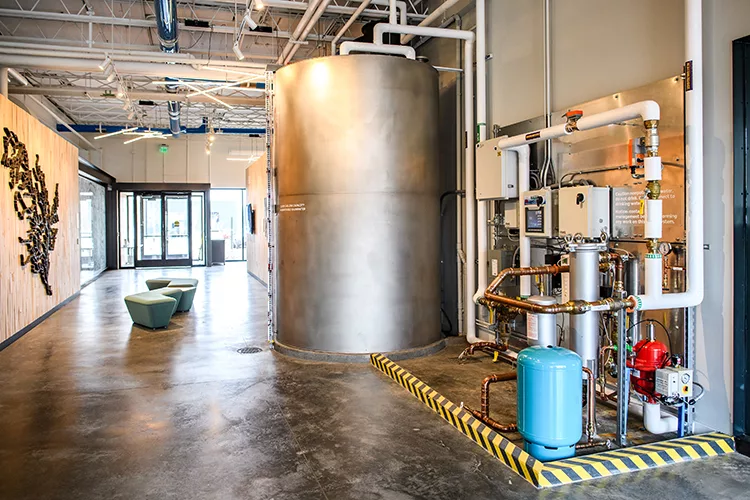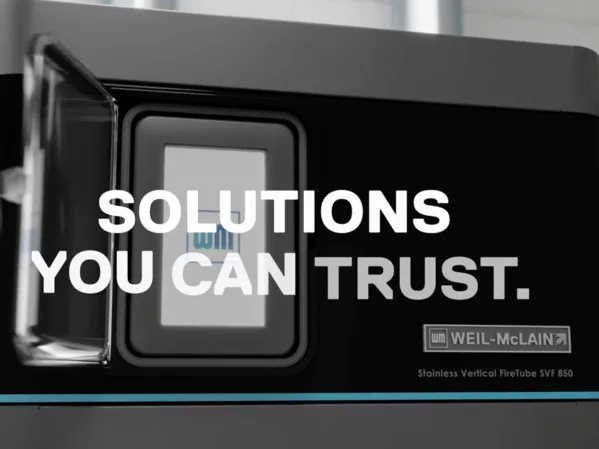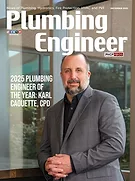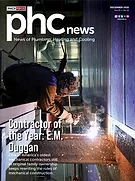In the nearly three decades since the Water Conservation and Water Use Efficiency Act of 1996 (commonly known as the Water Save Act), the plumbing industry has seen a slow but steady evolution toward more sustainable practices.
The legislation, which drastically reduced allowable water consumption for fixtures, laid the foundation for gradual innovation in water conservation in building systems.
Toilets were among the first fixtures to undergo major design changes, transitioning from 3.5 gallons per flush to 1.6 gpf as a national standard. Today, some models operate at just 1.28 or even 1.1 gpf.
These changes sparked a chain reaction throughout the plumbing code, driving innovation in flushing technology and requiring changes in piping standards.
One of the popular trends in green plumbing today is rainwater reuse systems, an approach that blends conservation with practical reuse. And it’s not just theory; it’s working in high-profile buildings right now.
At Harris, we are proud to support the long-term success of two prominent rainwater reuse systems: one at the Capitol Region Watershed District Office in St. Paul, Minnesota, and the other at Allianz Field, home of Minnesota United FC. We performed the installation at Allianz Field and handle the ongoing maintenance at both sites.
Rainwater reuse in action
At the Capitol Region Watershed District Office, sustainability is more than a mission, it’s built into the plumbing.
“The CRWD Board made the decision early in the design process of our new office building to make it a demonstration site for innovative stormwater management and sustainability,” says Forrest Kelley, PE, CRWD’s facility management division manager.
The facility features a rainwater reuse system, prominently placed in the CRWD office’s front lobby.
The system collects rainwater from the roof and directs it to a 3,000-gallon stainless steel cistern, where it begins a multistage filtration process.
The water collected from the 15,000-square-foot rooftop is pretreated by a Wisy Vortex filter that prevents larger particles from entering the tank.
Water is then pumped through a 50-micron self-cleaning Orival back flush filter, a 5-micron bag filter and a 5-micron carbon filter to remove odor and color. Finally, a Viqua UV light disinfection system is used to remove bacteria.
The end uses of the treated water are flushing nine toilets in the office restrooms, an interactive exhibit and pond in the pocket park and a commercial grade dishwasher used to clean stormwater sample bottles.
The system also features Opti’s web-enabled Continuous Monitoring and Activated Control technology, which is tied to National Weather Service forecasts. It’s able to send water from the tank to the rain garden outside in advance of a storm to make room for the anticipated rain.
The system reduces municipal water use, supports sustainability goals and provides a practical application for what would otherwise be stormwater runoff, which can pick up leaves, trash, salt and more as it flows over city streets and into storm drains and, eventually, reaching the Mississippi River.
“Part of CRWD’s mission is to educate its community members on water resource issues and get them interested in water quality protection and conservation,” Kelley says. “We often provide tours of our LEED Gold building and highlight the low impact development and sustainable stormwater measures incorporated throughout.”

Allianz Field
A similar but larger-scale system operates at Allianz Field, home of Minnesota United FC.
The stadium’s rainwater reuse infrastructure includes an underground 475,000-gallon cistern that collects runoff from the expansive roof. The captured rainwater is pumped through two inline pumps with variable frequency drives, then routed through a filtration system designed to handle high volume.
The water is first treated by backwashing prefilters that remove particles larger than 120 microns, with the resulting waste directed to the sanitary sewer system. The treatment skid balances filtration levels with flow demands by choosing the appropriate bag filter inserts and carbon filter cartridges before going through the UV disinfection lamps.
Finally, the water flows to a pressure boosting station that delivers it at approximately 115 psi, which is enough to power everything from traditional lawn sprinkler heads to drip lines and tree irrigation systems.
This system supports all the stadium’s landscape irrigation needs while minimizing reliance on municipal water, and was designed to accommodate future developments surrounding the stadium, supplying water to both public and private landscaped areas. It’s forward-thinking infrastructure that’s adaptable as the site grows.
What this means for the plumbing industry
In terms of functionality, these rainwater reuse systems check several boxes: they’re low-maintenance, reliable and efficient.
These projects exemplify the growing shift toward integrated water reuse systems, especially in municipalities and civic buildings committed to environmental responsibility.
Green plumbing is no longer just about swapping out fixtures, it’s about rethinking how water is collected, treated and reused throughout the life cycle of a building.
Systems like the ones at Allianz Field and the Capitol Region Watershed District are helping redefine what’s possible in sustainable plumbing. They represent smart, future-focused investments for companies that want to stay ahead of industry trends and environmental expectations.
Kelley expects systems that capture rainwater for outdoor irrigation uses will continue to gain popularity, especially as periods of both extreme drought and intense rainfall occur due to climate change.
“It will become increasingly important to have these types of alternatives in place to ensure we are not straining the municipal supply system and wasting resources treating to drinking water standards for non-potable uses like toilets and landscape irrigation,” Kelley adds.
The reality is, building owners and developers are under increasing pressure to meet sustainability goals.
Whether it’s pursuing LEED certification, lowering operational costs or simply being a better environmental steward, water reuse systems check a lot of boxes. They save money. They reduce the building’s footprint. And they give stakeholders a story worth telling.
For mechanical contractors, these systems offer more than just a cool project to add to the portfolio. They open the door to long-term service relationships: monitoring system performance, maintaining filters and pumps and helping clients adapt as their needs evolve.
There’s also a growing demand for expertise in controls and automation, as these systems often integrate with larger building management platforms.
At Harris, we see these types of projects as a multifaceted opportunity. It’s a way to grow business while helping communities manage resources more wisely.

Looking ahead
As water scarcity becomes a more pressing global issue, the demand for efficient, sustainable water systems will only continue to rise. We are already seeing major cities and institutions take proactive steps, and soon this won’t just be an option, it’ll be the standard, and the plumbing industry is uniquely positioned to lead the way.
Whether it’s installing ultra-low-flow fixtures or designing full-scale rainwater reuse systems, plumbers and mechanical contractors have a chance to be at the heart of meaningful environmental progress.
And it’s not just about doing what’s right, it’s about staying relevant, competitive and prepared for what the next decade will bring.
Today’s green plumbing trends are more sophisticated, more integrated and more impactful than ever. Projects like the ones at Capitol Region Watershed District and Allianz Field prove that sustainability and performance can go hand-in-hand.
They show clients and the broader public that these types of systems are here to stay, and the contractors who understand how to design, install and support them are shaping the future of plumbing. l
Andy Lyall is a project sales representative for Harris with 20 years of experience in the plumbing industry. Lyall previously served as a service plumber general foreman, specializing in new construction, remodeling and service in large-scale commercial projects.





